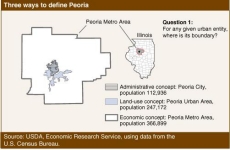Rural and Suburban America: When One Definition is not Enough
Rural and Suburban America: When One Definition is not Enough
Last week I was pleased to speak to the Rural Philanthropy Conference. They are a set of private and community foundations that identify problems and issues facing rural America and seek to improve the areas through foundation investments. They want to do good works and see the lives of rural peoples improve.
There was discussion about what “rural” really means. It is fair to say that rurality as a concept has for years been derived from first identifying various types of urban areas. In that sense, rural areas are residual to urban areas; everything that’s not urban is rural.

For example, looking at the area around Peoria, Illinois, illustrates the problem. If we use the city limits of Peoria as the urban unit, then we deduce more land as rural adjacent to it. If we identify land use patterns, then we bring into a Peoria urban area more space, mainly suburban ring areas. If we use commuting patterns and other data to describe a cohesive economic center, then the rural fringe shrinks even more. So, “urbanicity” (and thus “rurality”) is currently defined by various combinations of civil jurisdictions, population density, land use, and economic notions. Treating rural as “everything else” begs the question of what purposes need to be fulfilled by attention to rural areas. The problems that seemed most important to those at the conference were poverty, jobs, health service access, education, and community support. Census Bureau statistics show that there are more gasoline stations and museums per capita in nonurban areas, but fewer physicians and dentists. How many more gasoline stations and how many fewer physicians depend on how you define “rural.”
A few days earlier I spoke at a conference on the American suburbs. Some of the questions they were discussing also focused on basic definitions — what, after all should “suburban” mean? Where does the urban core begin and end? If population density increases around a civil jurisdiction, but the area is not annexed into the core city, is it suburban? The definitions of various types of urban areas are reviewed by the localities affected, together with statisticians and demographers at the Census Bureau and at the Office of Management and Budget.
Still there are dissatisfactions. There should be. We should expect this to be ever so.
A growing notion of statistical quality notes that a statistic is good to the extent that it is “fit for use.” The same statistic (e.g., the percentage of rural persons with less than a high school education) using one definition of rural may be exactly the right population of interest and measurement of educational attainment for one use, but quite inappropriate for another. The same statistic has higher quality for the first use than for the second.
So, wait a minute. Does that mean there is no such thing as “suburban” and “rural?” No. It means there are many potential definitions for the terms, many of them best-suited for different uses.
So, why, you might ask, do the Census Bureau and the Office of Management and Budget promote single official classifications? First and most narrowly, the Office of Management and Budget has been given the regulatory mandate to do so in Federal law for many statistical entities. Second, some uniformity in definition assists execution of Federal statistical programs. Third, they are committed under the law to seek wide input on such classifications; that is, the process is forced to be somewhat transparent. Fourth, a single definition facilitates comparisons over uses and over time, when it is followed.
Many classifications used by the Census Bureau garner controversy, often because they are not fit for all uses. Think of the controversies over race, ethnicity, industry, and occupational classifications. The controversies heat up when benefits or regulatory activities are connected to the classifications. Otherwise they are limited to the normal-science debates that permeate all of academia.
When definitions of terms matter, then the challenge of the statistical agencies is to bring to bear all the input from the diverse possible uses of statistics involved (attempting to maximize their fitness for as many uses as possible). It is appropriate, in my opinion, for these judgments to give more weight to Federal government statutory implementation needs. After all, Federal taxpayers are paying for Federal statistics.
With my scientist hat on, however, I realize that such classifications may not fit the needs of important research on the economy and the society. The relevance of the data collected by the Census Bureau to those uses is enhanced to the extent that the same data can be used (by summarizing them in different ways) to serve other uses. When we do that, we can serve the official governmental uses of a classification scheme as well as facilitate scientific studies.
For many important economic and social statistics there is no perfect single classification scheme. Being absolutely explicit about meaning of terms is important to assess their utility for a specific purpose.





